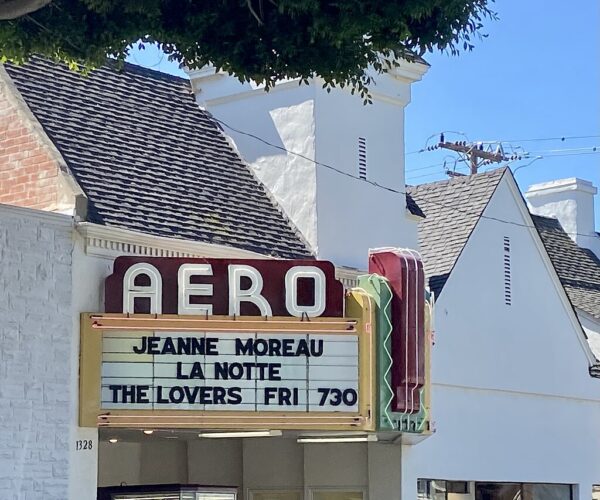
Place
Star Theatre (Demolished)
The Star Theatre was a lamella roof theater designed by master architect S. Charles Lee.
Lost
On June 17, 2019, the Star Theatre was demolished to make way for a residential development project.


Place Details
Address
Architect
Year
Style
Community

Photo courtesy Architectural Resources Group
Overview
Located at the corner of First and Workman Streets in Old Town La Puente, the former Star Theatre was notable as the only surviving lamella roof theater designed by master architect S. Charles Lee in Los Angeles County. It was demolished in June 2019.
Constructed between 1947-48 and opened as the Puente Theatre, it was a rare and significant example of Lee’s postwar theater designs, designed and built during the final years of his career and showcasing his continued experimentation with new forms and technology to respond to changing needs.
Utilizing wood lamella construction for its roof and featuring monumentally scaled, freestanding signage that rose twice the height of the theater building, Lee’s design for the Star Theatre was directly influenced by two important postwar-era trends: lingering wartime restrictions on building materials and the growing prominence of the automobile.
The Star Theatre’s programming changed with the times, screening adult films in the late 1970s and ’80s and switching to first-run family films with Spanish subtitles in the early 2000s. It most recently operated as a first-run cinema prior to closing in 2007.
About This Place
About This Place
Lee designed a total of five lamella roof theaters in California during the late 1940s, two each in Los Angeles and San Diego Counties and one in Tulare County. Three have been demolished, with one remaining in both San Diego and Tulare counties.
Lamella construction, introduced to the United States in 1925 and used primarily for industrial structures and building types such as auto showrooms and grocery markets, is comprised of diamond-shaped bracing formed of short lengths of lumber that can span great distances without view-obstructing columns or trusses. Lee embraced another benefit afforded by lamella construction, as it required no steel and wood was an unrestricted material. While the lower curved walls of the auditorium’s interior are plastered, the distinctive diamond-shaped bracing of the lamella roof is left exposed to form the ceiling.
The Star Theatre was unique among Lee’s five lamella roof theaters as the only one in which the half-cylinder shape of the roof also forms the design of the façade. The other four were designed with rectangular facades that concealed the shape of the auditorium from the street. As such, only the Star Theatre conveys its iconic form from the exterior. The distinctive façade retains its original aluminum-framed windows and entry doors.
Another unusual feature of the Star Theatre was the monumentally scaled signage, situated directly adjacent to the front right corner of the theater. While Lee was a major innovator of integrated signage for his theater designs, several examples of which reached lofty heights aimed at attracting patrons traveling in their automobiles, the signage he designed for the Star Theatre is unique among theater buildings for its size and scale as a freestanding sign and its dual function as a giant flagpole, rising twice the height of the theater building. The sign structure is comprised of five alternating pairs of slim metal poles evenly braced by horizontal members, which lends a striking grid-like appearance. A large, neon-illuminated star is perched atop the structure, next to a flagpole rising above the outermost pole.
The Star Theatre is profiled in the 1994 S. Charles Lee monograph The Show Starts on the Sidewalk: An Architectural History of the Movie Theater by Maggie Valentine, Ph.D, architecture professor at the University of Texas at San Antonio. The University of California, Los Angeles holds the S. Charles Lee Collection, which contains numerous historic photographs of the Star Theatre under construction and following completion.
Our Position
Following publication of an article detailing the proposed development in the San Gabriel Valley Tribune dated May 8, 2017, the Conservancy learned that the City of La Puente was not planning on preparing an EIR to evaluate the project.
The Conservancy submitted a letter to La Puente in June 2017 highlighting the historic significance of the Star Theater and citing CEQA (California Environmental Quality Act) case law that firmly establishes the city’s obligation to prepare an EIR for the project. The Conservancy also provided technical assistance to local advocates who have long considered the Star Theater a significant resource that should be preserved and adaptively reused rather than needlessly lost to development.
The Conservancy previously met with the property owner and representatives from the City of La Puente in October 2017, and provided more information on CEQA and the obligation of the City and owner to consider and evaluate a range of preservation alternatives that could retain the Star Theater as part of the project. La Puente has no historic preservation ordinance or related policies in place, and received the grade of “F” on the Conservancy’s Preservation Report Card.
As a direct result of the Conservancy’s advocacy efforts, the City of La Puente recognized the Star Theatre as a historic resource and the proposed project was reviewed through the California Environmental Quality Act (CEQA) and Environmental Impact Report (EIR).
The first phase of the EIR was released in July 2018 and the Conservancy submitted comments on the Notice of Preparation (NOP) with a focus on the range of preservation alternatives and adaptive reuse options we’d like to see explored in the draft EIR.
The draft environmental impact report (EIR) for the project that would replace the historic Star Theatre in La Puente with a 22-unit condominium project was released on December 10, 2018.
On June 17, 2019, the Star Theatre was demolished to make way for a residential development project.
How You Can Help
Learn more about this issue and how you can help other historic theatres from the Los Angeles Historic Theatre Foundation (LAHTF).


